Greenhouse Farming Business Plan:
The following information is about Greenhouse Farming Business Plan, Types of Greenhouses, Construction of Greenhouses, and Maintenance of Greenhouse.
Introduction: Greenhouse farming is the latest technique of farming that is establishing very fast around the world. The greenhouse farming business is earning huge profits. The establishment of a greenhouse is a bit expensive, and all the banks and governments are providing loans and subsidies. This article will provide complete information about the construction and maintenance of the greenhouse.
Greenhouse Farming Business Plan – What is a Greenhouse?
A greenhouse is a farming technique, where a house is constructed with transparent materials like glass or polyethylene, or wood, and plants are grown inside the house under controlled environments. The size of the house varies from small sheds to large buildings. The greenhouse is mostly constructed with glass, that keeps the house warm during the day and blocks the greenhouse gas to exit. Even during cold temperatures, greenhouses provide a warm environment for the plants. Greenhouses are embedded with heat, lighting, screening, and cooling systems. Greenhouses implement the latest high-end technologies with computerized systems to provide optimal growth conditions for plants.
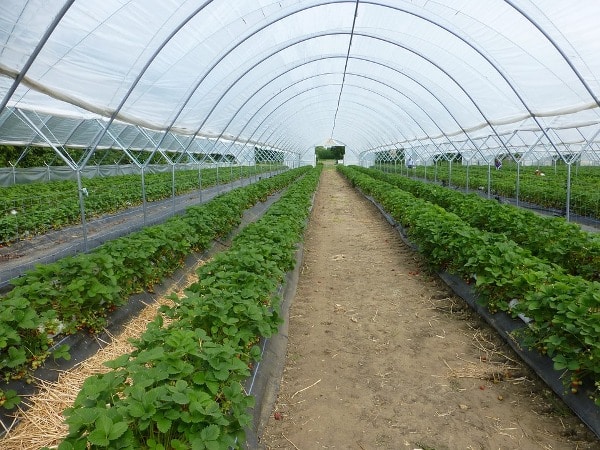
What is a Polyhouse?
Poly House is a type of greenhouse, constructed using polyethylene as cover instead of glass or wood. It is the most popular and commonly used greenhouse technology. Poly house is very economical compared to other greenhouse farming techniques. All types of crops are grown in poly houses.
- Fruits: Papaya, Strawberry, Banana, Guava, Apples, etc. are grown in poly houses.
- Vegetables: Bitter gourd, Cabbage, Capsicum, Colored Bell Peppers, Cauliflower, Chili, Coriander, Herbs, Brinjal, Onions, Potatoes, Tomatoes, Beans, etc. are grown in poly houses.
- Flowers: Carnations, Chrysanthemum, Gerbera, Gladiolus, Marigold, Orchid, Rose, Lily, Hibiscus, etc. are grown in Polyhouse.
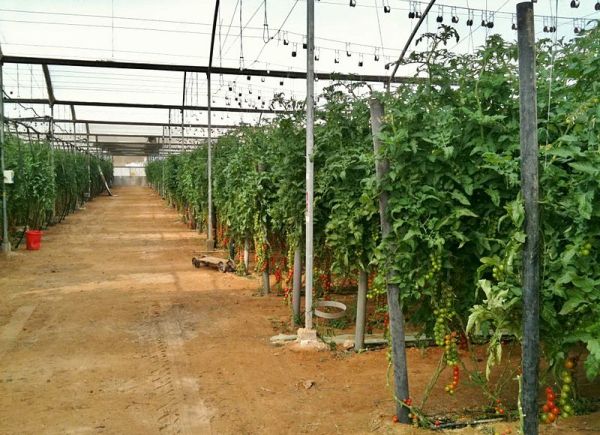
Greenhouse Farming Business Plan – Steps to Start a Greenhouse:
Greenhouse Farming Business Plan – Selection of the Site for Greenhouse
Selecting a site for constructing a greenhouse is as important as selecting construction materials, seeds, plant nutrients, and other equipment. Consider the following steps while selecting a site.
- Sunlight: Plants need a sufficient amount of sunlight to grow, low sunlight may cause slow growth, and fruit and flower abortion which results in low yields and low profits. The site of a greenhouse should have good access to sunlight throughout the year. Locations that don’t receive enough sunlight in winter will need supplemental lighting.
- Water: The site should have a good water supply, as each plant needs one gallon of water with nutrients daily and an additional amount of water for evaporative cooling. And approximately it needs 10,000 to 15,000 gallons of water per acre each day. And the acidic levels of water should be tested for salt and pH levels in it, these levels of adjusted as per requirement. So, a site should have good water resources.
- Elevation: Elevation plays a key role in high summer and low winter seasons, which affects the cooling and heating costs. If the site selected is at a higher altitude, you should take the necessary steps in controlling temperatures.
Greenhouse Farming Business Plan – To Control the Temperature
- In high elevated areas, you should place temperature alarms in greenhouses that indicate a temperature fall. And you need to purchase a ceramic heater to increase the temperature.
- In peak summer, you need automatic operating water systems. And use an automatic vent opener to control the heat.
- Microclimate: there are many factors that can affect the environment like latitude. Don’t choose a site near large water bodies, mountains, and other obstructions these can create many obstructions in the greenhouse environment.
- Pests: The site should be away from agricultural areas or create a buffer zone between your operation and the agricultural areas to prevent pest infection.
- Level up the ground: Level the ground and make it stable. The ground must also be graded for water draining. And the ground should be compacted so that it gets settled before the construction of a greenhouse.
- Transport Facility: you should have good access to roads for transportation. Uneven roads can damage your fruits or vegetables.
- The direction of a greenhouse: the direction of the greenhouse and the plants in the greenhouse should be in the north, south direction, this increases the amount of sunlight that enters the house and creates good ventilation.
- The Size of the site: the amount of land you purchase should be more than the requirement so that you can easily extend the greenhouse in the future if required.
- Human Resource: For managing a greenhouse you need two types of workers one is trainable laborers and categorized laborers. Trainable laborers will take care of plants and harvesting jobs. And the categorized laborers include growers, production managers, nutritionists, pest control specialists, supervisors, and marketing specialists.
- Utilities: Utilities include telephones, three-phase electricity, and fuels for heating/CO2 generation.
- Management Residence: The manager and growers should be available round the clock, so they should stay near to the greenhouse in the event of an emergency.
Greenhouse Farming Business Plan – Types of Greenhouses
Structure Greenhouse should be designed for a controlled irrigation system, the designs should facilitate the penetration of light and cover all the plants. So, greenhouses have semi-circular shapes structured made with some transparent materials like plastic covers, glasses, and other transparent materials. The main features of a greenhouse structure are, they should maintain temperature levels, humidity levels in the air, watering systems, pest control techniques, and should have inbuilt systems that supply plant nutrients. Types of greenhouses are classified based on their cost, suitability, structure designs, ventilation, environment control, and size of farming.
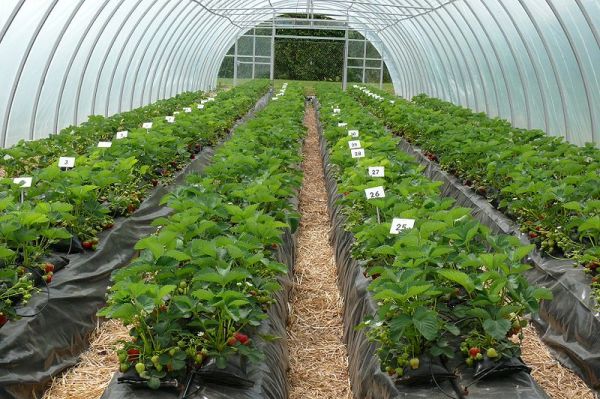
Greenhouse Farming Business Plan – Greenhouses Based on Cost and Suitability
- Greenhouse Farming Business Plan – Low-Cost Greenhouses: Bamboo greenhouse could be the best option for small and medium-scale farmers with small agricultural land. these greenhouses are constructed with minimum cost using materials like bamboos or other staking materials. These greenhouses are usually used polyethylene as covering materials. Sunlight is controlled using fine green nets. These greenhouses use simple techniques like sidewall opening, closing to maintain temperature levels in summer and winters. These houses don’t implement any high-end technology all techniques implemented are very simple and manual. These greenhouses are suitable for cold places. The cost of construction varies between 400 to 500 rupees per square meter. But these greenhouses cannot stand in heavy winds and storms. And even cannot work in high summer temperatures.
- Greenhouse Farming Business Plan – Semi-automatic Greenhouses: this type of greenhouse is most popular and suitable for small and medium-scale farmers. these greenhouse structures are constructed with the pipe and the canopy is held together with the help of screws. These greenhouses are constructed firmly and with semi-automatic techniques farming techniques. Temperature is controlled with exhaust fans with a thermostat system. This type of greenhouses uses cooling pads and misting systems to maintain the humidity levels. The cost of construction per unit of this semi-automatic greenhouse varies from 800 to 1100 rupees per square meter.
- Greenhouse Farming Business Plan – High-End Greenhouse: these types of greenhouses implement high-end technologies to maintain temperature, humidity levels, and other environmental parameters. This type of greenhouse farming is suitable for large-scale farming or hydroponic commercial framing. The cost per square is 2000 to 3500 per square approximately.
Greenhouse Farming Business Plan – Greenhouses Based on Structures
There are three types of greenhouses categorized based on the type of material used for structures such as PVC frames, steel rods, etc. They are Quonset Greenhouses, Curved Roof Greenhouses, and Gable Roof Greenhouses.
- Quonset Greenhouses: Quonset greenhouses have semi-circular structures that resemble like clear barrels, cut in half. Quonset greenhouses are efficiently constructed with indestructible Kee Klamp fittings. The main advantage of Quonset greenhouses is their freestanding architecture, which gives enough sunlight for irrigation. The construction of the Quonset greenhouse is very simple.
- Curved Roof Greenhouses: Curved Roof greenhouses are covered with lighter materials like polyethylene and polycarbonates.
- Gabled Roof Greenhouses: Gabled Roof Greenhouses are suitable for heavy coverings like glass or fiberglass.
Greenhouse Farming Business Plan – Greenhouses Categorized on Glazing: Greenhouses classifies based on the type of material used for covering the structure. They are Fiberglass reinforced plastic glazing, glass glazing, and plastic film glazing. Plastic film glazing is the most popular covering material for a greenhouse.
Greenhouse Farming Business Plan – Structural Components: Greenhouse use rafters for vertical support. Rafters are of truss type, or curved arch depending on the width of the greenhouse. Purlins are used for horizontal support that attached from rafter to rafter. Spacing between the structural components depends upon the size of the greenhouse. Side posts and columns are used for vertical support.
Greenhouse Farming Business Plan – Farming Materials for Greenhouses: Greenhouses are constructed with different materials. The most popular materials used are aluminum, steel, and wood. Aluminum is the most economical among the three, rafters and side posts and other structural components are formed with these materials. Wood is not preferred as it deteriorated quickly.
Greenhouse Farming Business Plan – Covering Materials for Greenhouses: Greenhouses are covered with transparent materials that provide optimum light transmission and should be more durable. Many materials available in the market to meet requirements on a commercial basis.
- Glass provides better light for a greenhouse that promotes optimum growth of plants. The structural components used to support glass covering are a bit expensive.
- Fiberglass is another cover material that is most the common item used for commercial greenhouse farming. Fiberglass is more durable and doesn’t require extensive structural components for the greenhouse. The main disadvantage of fiberglass is very susceptible to break down due to UV rays. And the lifespan of fiberglass is very less it should be replaced every 5 years in the case of reduced light transmission.
- Double sheets of polyethylene film are another best option and most popular option used for commercial greenhouse farming. these sheets are not rigid and provide the necessary support for normal operations. The life span of these sheets is very less, they should be replaced every two years. These sheets require very few structural components and very economical.
- Another covering material used for greenhouses is polycarbonate and acrylic materials. the efficiency and productivity of greenhouses depend upon their design, structural components, and covering materials.
Greenhouse Farming Business Plan – Designs of Greenhouses
Greenhouse design depends upon its number of spans and environment.
Greenhouse Farming Business Plan – Greenhouse Design Based on Number of Spans
- Free Standing or single span.
- Multispan or ridge and furrow or gutter connected.
Greenhouse Farming Business Plan – Greenhouse Design Based on Environment
- Naturally Ventilated.
- Passive Ventilation.
Greenhouse Farming Business Plan – Types of Polyhouse Based on Environment
The crops grown in open fields are exposed to vivid environmental conditions, attacks of insects and pests, whereas Polyhouse provides a more stable environment. Polyhouse is divided into two types:
- Naturally Ventilated Polyhouse: this type of Polyhouse doesn’t have an environmental control system. They have a provision for adequate ventilation and a Fogger system.
- Environmentally controlled Polyhouse: this type of Polyhouse has all techniques to create a suitable microclimate for the growth of plants irrespective of the environment outside.
Shade Houses
Shade houses are used to grow plants in warm climates or in hot summers. All the plants that are grown in shade are grown in shade houses. Shade houses are mostly constructed as a pole-supported structure and covered with lath or polypropylene shade fabric. Black, green, and white-colored nets are used, while black colors are the most preferred as it retains heat outside.
Greenhouse Farming Business Plan – Orientation of Greenhouse
The design of the greenhouse is should facilitate the controlled environment for plant growth. Several techniques are implemented to create a controlled environment for plant production. Creating a controlled environment requires more capital investment, the amount is calculated per unit. The profits in the greenhouse farming business depend upon the structure, covering materials and environment controlling systems along with a proper design of the greenhouse.
The structure of Greenhouse should be able to carry the following loads
- Dead Load: The structure of the greenhouse should carry the weight of contrition equipment, classing, heating and cooling equipment, the weight of pipes, etc.
- Live load: The greenhouse should be capable of holding containers, shelves and persons working on The greenhouse should be designed to hold a maximum of 15 kg per square meter live load.
- Wind load: The structure of the greenhouse should withstand winds of 110 kilometers per house and should hold at least 50 kg per square meter wind pressure.
- Snow Load: In heavy snowfall regions, the structure of the greenhouse should be capable of holding snow.
Greenhouse Farming Business Plan – Direction of a Greenhouse: The direction of the greenhouse should consider wind direction, the latitude of the location, and the type of temperature control system. Single greenhouse with latitude 40° N should have a ridge running east to west to allow low angle light to enter from the side rather than ends. Single greenhouses below 40° N should have a ridge running from north to south. The location and orientation of the greenhouse should avoid falling shadows on the adjacent greenhouses. To avoid shading, one greenhouse to another greenhouse should be oriented east to west.
Greenhouse Farming Business Plan – Wind direction for Greenhouse: For a naturally ventilated greenhouse, natural air should be flown throughout the house. The dimension of the greenhouse should be perpendicular to the wind flow direction. For fan and pad greenhouse the natural wind direction and fan air should be in the same directions.
Greenhouse Farming Business Plan – The Size of the Greenhouse: Small greenhouse doesn’t require temperature controllable techniques, it just needs proper ventilation. A bigger greenhouse without ventilation needs more temperature buildup. Naturally ventilated greenhouse length should be below 60 m.
Greenhouse Farming Business Plan – The Space between Greenhouse: One greenhouse should not enter the adjacent greenhouse. The space between the natural ventilated greenhouse should be between 10 m to 15 m.
Greenhouse Farming Business Plan – Height of Greenhouse: Ideal height of the greenhouse should be 5m for 50m X 50m. Height of the greenhouse can reduce as per the size of the greenhouse.
Greenhouse Farming Business Plan – Structural Design: The structural design should be designed following all the safety measures. The structure should be capable of holding a dead load, live load, wind, and snow loads.
Greenhouse Farming Business Plan – Components of Greenhouse:
Components are the basic materials required for the construction of greenhouses. Below are the basic components required for the construction of greenhouses.
- Roof: The roof of the greenhouse should be covered with a transparent cover like glass, fiberglass, or polyethylene.
- Gable: A gable is a triangular portion of a wall between the edges of intersecting roof pitches. For greenhouses, a transparent gable is used.
- Cladding Materials: Cladding materials are used to cover a greenhouse. Cladding materials show a great impact on the quality of radiation the crops are exposed to, and the crop yields. The greenhouse cladding is an essential component of the growing environment inside, popular cladding materials used are glass and hard or soft plastic sheets.
- Gutter: The gutter is used to collecting and draining the rainwater and snow, gutter is placed on an elevated level between the two spans.
- Column: A column is a vertical structure that carries the greenhouse structures.
- Purlin: Purlin is a component that connects cladding supporting bars to the columns of the greenhouse.
- Ridge: Ridge is the highest horizontal section at the top of the roof.
- Girder: Girder is a horizontal structure component that connects columns on gutter height.
- Bracings: Bracings are the components used to support the structure of the greenhouse against the wind.
- Arches: Component used as a support for covering materials.
- Foundation Pipes: Foundation pipes are used to connect the structure and the ground.
- Greenhouse Length: Dimension of the greenhouse in direction of the gable.
- Greenhouse width: Dimension of the greenhouse in direction of the gutter.
Greenhouse Farming Business Plan – Cladding Materials for Greenhouses
The most common and economical cladding material used for greenhouses is polyethylene. Now long-lasting, unbreakable, and light roofing panels -UV stabilized clear fiberglass and polycarbonate panels are also available in the market. Plastic is used in tropical and sub-tropical areas.
Greenhouse Farming Business Plan – Covering Materials for Greenhouses
- Polyethylene: Polyethylene has less durability; maximum durability is 1 year and has high maintenance.
- Polyethylene UV resistant: Normal polyethylene covers are damaged due to UV rays, use UV resistant polyethylene. The durability of this polyethylene is two years and maintenance is very high.
- Fiber Glass: Fiberglass is suitable for commercial greenhouse farming and durability is seven years. And need low maintenance.
- Tedlar coated Fiberglass: this fiberglass is used for commercial greenhouse farming and has a durability of 15 years. And have a very low maintenance cost.
- Double strength Glass and Polycarbonate: these are also more durable covering materials that have very low covering materials.
Greenhouse Farming Business Plan – Containers for Greenhouse Farming
Containers have greater significance in greenhouse farming. the containers are easy to handle and give good yields with easy maintenance. there are many types of containers used for plant growth in greenhouses.
- Clay pots: Clay pots are low in cost and have easy water management. But clay pots dry out quickly.
- Fiber Blocks: these containers are easy to handle but have a very short life and the growth of the plant is very slow.
- Fiber tray: these containers occupy very little space, but these trays are hard to handle.
- Single Peat Pallet: these containers don’t require growing medium and have less space. Only limited sizes of plants are grown in these containers.
- Strip peat pot: these containers good for root penetration.
- Portrays: Portrays are easy to handle and are suitable for plants of small size.
- Plastic pack: these containers are easy to handle, but the roots are grown out of the container.
- Plastic Pots: these are reusable containers good for root penetration and can handle a single plant.
- Polyurethane foam: these are easy to handle and required regular fertilization.
- Soil band: Good for root penetration, but requires less labor.
- Soil block: Good for root penetration, but need expensive machinery.
- Plastic tray: Comes in many sizes and requires a less growing medium, but roots may grow out of the container.
- Perforated: these are less expensive and less durable.
- Polyethylene: these are reusable bags, required less storage space.
Select the suitable container depending on the crop grown, plant characteristics, growing habit, root system, etc. Long crops with deep-rooted systems require large containers. The container provides optimum conditions for germination of seed and growth and development of transplants.
Greenhouse Farming Business Plan – Environmental Factors that Influence Greenhouse Farming
The best environment will maximize the yields and quality. Environmental factors that influence greenhouse are:
- Natural Ventilation: The greenhouse needs good ventilation to control the temperature. The built-in temperature in the greenhouse should not exceed 2° round the year.
- An unconventional method of heating and cooling: hot and cold water should be sprinkled on the greenhouses covered externally with the shade net. An earth tunnel is used for cooling in summer and heating in winter. Water circulating pipes are arranged on the floor of the greenhouse.
- Heating techniques for greenhouse: to heat up temperatures in peak winters, a double covering of glazing with an air cushion is used. Some heating techniques implemented in greenhouses are boilers, supplying hot water through pipes, unit heaters, infrared heaters, and solar heaters.
- Temperature control: to control the temperature in the greenhouse, a thermostat is coupled with water circulating pump or exhaust fan is used to control temperature.
- Humidity Control: to maintain the humidity levels in the greenhouse, the humidity is coupled with water circulating pumps or exhaust fans to control the relative humidity inside the greenhouse.
- Light Control: in the regions where the light intensity is less, we need to provide artificial light sources. Incandescent bulbs or fluorescent bulbs are used to provide an artificial light source for plants.
Read this: Asparagus Cultivation.
Greenhouse Farming Business Plan – Watering /Irrigation Systems In Greenhouse Farming
The plant requires a good amount of water and nutrients. the micro irrigation system is the best watering technique in a greenhouse. Micro sprinklers or drip irrigation equipment are used for watering. Watering systems should ensure that water doesn’t fall on the leaves or flowers, water should directly reach the base of the plants.
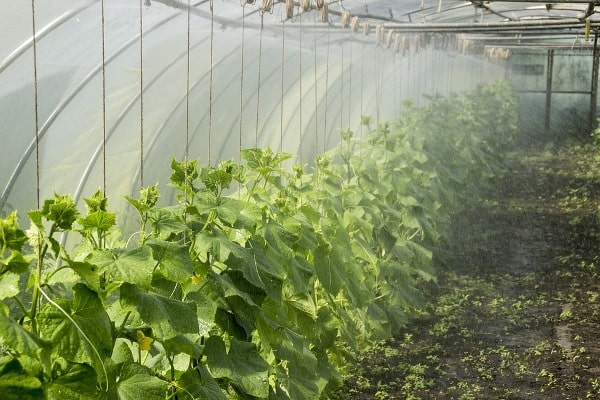
Types of drippers are:
- Labyrinth drippers.
- Turbo drippers.
- Pressure compensating drippers.
- Button drippers.
- Pot drippers.
Greenhouse Farming Business Plan – Maintenance of Greenhouse
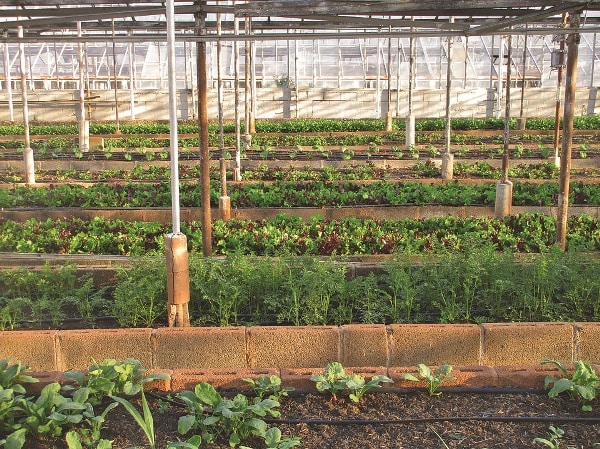
Greenhouses need constant maintenance, it is compulsory to check the greenhouse on a regular basis to ensure the environmental and growth conditions of the plant. Basic things that should be checked are:
- Pest control: Pests are a major problem in the greenhouse that needs constant monitoring. Every single plant should be inspected. Don’t even ignore the common pests, they may begin to multiply at a super speed.
- Cleaning: The greenhouse should be clean regularly with disinfectant cleaners. Use mild cleaners and warm water to clean the floor and counter of the greenhouse. To keep away the pests from the greenhouse, fumigate the greenhouse yearly.
- Ventilation: The ventilation system should be monitored regularly to ensure that it is not malfunctioning. When the shutters and louver get squeaky oil them.
- Water tank and Irrigation system: Connected lines and hoses of the watering system need to be checked every couple of months. The hoses may become clogged or they develop cracks, so they should be replaced. Dirt in hoses can be cleaned by running water at full pressure without the cap.
- The roofs of the walls should be washed regularly as the dust settles on them and reduces light transmission. The greenhouses should be solarized annually, solarization is done by mulching.
Problems in Greenhouses: there are many troubles that arise in greenhouse farming some of them are listed below:
- Failure to supply the essential factors like light, moisture, carbon dioxide, and heat.
- Fertilizer deficiencies: plant shows the deficiencies of fertilizers, some of them are Chlorosis, Necrosis, Nitrogen Deficiency, Phosphorous Deficiency, Potassium Deficiency, Calcium Deficiency, Iron Deficiency, etc.
- Fertilizer Excess: Overdosage of fertilizer to plants results in damage to crops. Excess levels of nitrogen, phosphorus, potassium, calcium, iron, sulfate, aluminum, boron can soil growth of plants.
- Air circulation, overwatering, underwatering are also some problems in the greenhouse.
- the plant should be monitored constantly and ensure that plants get necessary nutrients in adequate quantities.
Greenhouse farming is a bit expensive, but a fruitful business. Many, subsidies and loans are provided by the governments and banks at a reasonable interest rate to encourage farmers. Before entering into the greenhouse farming business make a complete study of greenhouse farming technologies, production technologies, cost component,s and problems to make your business attempt a grand success.
In case if you are interested in this: How To Grow Strawberries in Greenhouse.
- How to Make Houseplants Bushy: Effective Tips and Ideas
- Innovative Strategies for Boosting Coconut Pollination and Yield
- Pollination Strategies for Maximum Pumpkin Yield
- The Complete Guide to Chicken Fattening: Strategies for Maximum Growth
- Natural Solutions for Tulip Problems: 100% Effective Remedies for Leaf and Bulb-Related Issues
- Revolutionizing Citrus Preservation: Towards a Healthier, Greener Future
- Natural Solutions for Peony Leaf and Flower Problems: 100% Effective Remedies
- Maximizing Profits with Avocado Contract Farming in India: A Comprehensive Guide
- Natural Solutions for Hydrangea Problems: 100% Effective Remedies for Leaf and Flowers
- The Ultimate Guide to Choosing the Perfect Foliage Friend: Bringing Life Indoors
- From Sunlight to Sustainability: 15 Ways to Use Solar Technology in Agriculture
- The Ultimate Guide to Dong Tao Chicken: Exploring from History to Raising
- The Eco-Friendly Makeover: How to Convert Your Unused Swimming Pool into a Fish Pond
- Mastering the Art of Delaware Chicken Farming: Essentials for Healthy Backyard Flocks
- 20 Best Homemade Fertilizers for Money Plant: DIY Recipes and Application Methods
- How to Craft a Comprehensive Free-Range Chicken Farming Business Plan
- Brighten Your Flock: Raising Easter Egger Chickens for Beauty and Bounty
- How to Optimize Your Poultry Egg Farm Business Plan with These Strategies
- Subsidy for Spirulina Cultivation: How Indian Government Schemes Encouraging Spirulina Farmers
- Ultimate Guide to Raising Dominique Chickens: Breeding, Feeding, Egg-Production, and Care
- Mastering the Art of Raising Jersey Giant Chickens: Care, Feeding, and More
- Ultimate Guide to Raising Legbar Chickens: Breeding, Farming Practices, Diet, Egg-Production
- How to Raise Welsummer Chickens: A Comprehensive Guide for Beginners
- How to Protect Indoor Plants in Winter: A Comprehensive Guide
- Ultimate Guide to Grow Bag Gardening: Tips, Tricks, and Planting Ideas for Urban Gardeners
- Guide to Lotus Cultivation: How to Propagate, Plant, Grow, Care, Cost, and Profit
- Agriculture Drone Subsidy Scheme: Government Kisan Subsidy, License, and How to Apply Online
Hello Sir,
I am just curious to know about the process of Hydroponics farming and the advantages, can I get some information regarding the same.
I am Interested to Know about the Process Of Farming of Dutch Roses in 4000 sq ft area ,
About there Advantages, Cost And Any Other Information.
We will update the project report of Dutch Roses in Greenhouse farming very soon.
I am interested in starting a small nursery I am new to the industry hence requesting you to guide appropriate initiative to begin in 1 acre farm land
It’s good idea to set up a plant nursery. Here is detailed guide of Plant Nursery Information for Beginners.
I am interested to set up a green house in Odisha ( Koraput dist) and also in pipili ( near Bhubaneshwar) initially in 5 acre land.
I want to produce vegetables and export quality cut flowers.
To back power, I want to add solar energy unit in the green house farming.
What will be project cost and profitability analysis.
How can I get detailed project report ( DPR) for this.
Can anybody help me in this regard?
Regards
Manoranjan
You can get some Information here: Polyhouse Subsidy, Cost and Project Report.
i would like to get advice and recommendation of greenhouse and hydroponics
HI SIR, I WILL LIKE TO HOW CAN I START GREENHOUSE OF CHERRY TOMATO AUTOMATION AND MONITORING SYSTEM DESIGN AND IMPLEMENTATION